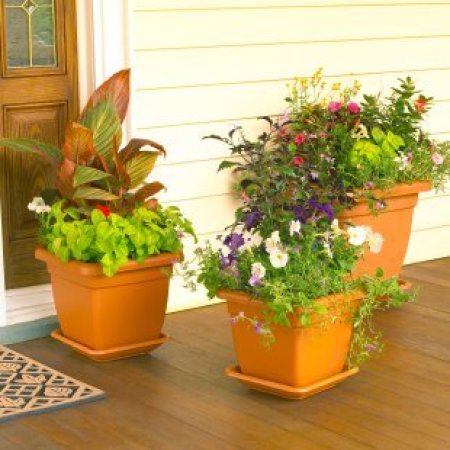For most of us, the first hard frosts of fall mark the end of container gardening season. Here are some tips for tidying up your dead or dormant plants, moving your favorites indoors, and cleaning up and storing your containers for the winter.
If your containers include tropical plants or tender perennials that you plan to overwinter indoors, start getting them used to their new environment well in advance of freezing temperatures, (and before you turn on your home's heating system). Water them well and set them in a shady, protected spot for a few days before bringing them indoors. During this time, check them over carefully for signs of pest problems and treat them with an insecticidal soap if necessary.
Decide which plants are worth saving. Although it is tempting to bring all of our container plants indoors for the winter, most of us simply don't have the space. To help decide which plants are worth saving, ask yourself the following questions:
If you are growing hardy perennials and are willing to risk losing them, just water them enough to prevent them from drying out and let them be. If you can't risk losing them but you don't have room for them indoors, here are several ways to increase the odds that they will survive outdoors:
Soil expands as it freezes, and even the best containers will crack if soil is left in them over the winter. Your containers will last much longer if you empty them out and store them inside. If they are light enough to move, dump any remaining plant debris and potting soil into your compost pile, and scrub containers with a stiff brush or scouring pad to remove any remaining dirt.
Finally, rinse them with a solution of one part bleach to nine parts water and let them air dry. Containers should be stacked upside-down in a frost-free environment like a basement, garden shed, or garage. Weatherproof containers (not ceramic or thin-walled terra cotta) can be turned over and left outside, providing you remove the potting soil.

About The Author: Ellen Brown is an environmental writer and photographer and the owner of Sustainable Media, an environmental media company that specializes in helping businesses and organizations promote eco-friendly products and services.
Add your voice! Click below to comment. ThriftyFun is powered by your wisdom!
If you have geraniums in containers, you can remove the plant, and most of the soil attached, then cut them down to about 4 inches and place just the plant(or plants) in a paper grocery bag and store the bag where it won't get frozen.
In the spring, check them occasionally as they will start growing out and then after all chance of frost is over, you can plant them back in their containers and enjoy them for another year.
Add your voice! Click below to comment. ThriftyFun is powered by your wisdom!